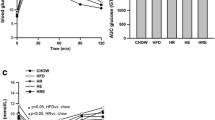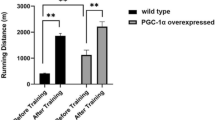Abstract
The high accumulation of lipid droplets in the cell is related to metabolic disorders, such as obesity. Perilipin 5 (Plin5), plays an important role in triglyceride hydrolysis in the lipid droplets. In this study, this protein has been evaluated in different tissues and conditions in mice. Fifty male mice were divided into 5 groups and treated for 45 days with Resveratrol, Metformin, strength training, and 4 °C cold. Brown adipose tissue (BAT), gastrocnemius skeletal muscle and heart were isolated for RNA extraction. The Plin5 gene expression was evaluated, using Real-Time PCR, and the plin5 was analyzed at the protein level, using western blot. In BAT, Resveratrol significantly reduced the plin5 protein level and gene expression (p < 0.05). In heart tissue, Resveratrol and strength training, decreased (p < 0.05) the plin5 expression, but Metformin increased the gene expression (p < 0.05). In skeletal muscle, resveratrol, strength training, cold and Metformin significantly increased the plin5 expression at the gene and protein level (p < 0.05). In BAT, Resveratrol has a greater effect in decreasing lipid deposits, compared with the strength training and cold; thus, it can play a better role in preventing lipid accumulation. In heart tissue, Resveratrol probably decreases insulin resistance, due to the increased expression of plin5 in skeletal muscle.



Similar content being viewed by others
References
Sikaris, K. A. (2004). The clinical biochemistry of obesity. The Clinical Biochemist Reviews, 25(3), 165.
Bravo, P. E., Morse, S., Borne, D. M., Aguilar, E. A., & Reisin, E. (2006). Leptin and hypertension in obesity. Vascular Health and Risk Management, 2(2), 163.
Itabe, H., Yamaguchi, T., Nimura, S., & Sasabe, N. (2017). Perilipins: a diversity of intracellular lipid droplet proteins. Lipids in Health and Disease, 16(1), 83.
Guo, Y., Walther, T. C., Rao, M., Stuurman, N., Goshima, G., & Terayama, K., et al. (2008). Functional genomic screen reveals genes involved in lipid-droplet formation and utilization. Nature, 453(7195), 657–661.
Sahu-Osen, A., Montero-Moran, G., Schittmayer, M., Fritz, K., Dinh, A., & Chang, Y.-F. et al. (2015). CGI-58/ABHD5 is phosphorylated on Ser239 by protein kinase A: control of subcellular localization. The Journal of Lipid Research, 56(1), 109–121.
Wolins, N. E., Quaynor, B. K., Skinner, J. R., Tzekov, A., Croce, M. A., & Gropler, M. C., et al. (2006). OXPAT/PAT-1 is a PPAR-induced lipid droplet protein that promotes fatty acid utilization. Diabetes, 55(12), 3418–3428.
Hsieh, K., Lee, Y. K., Londos, C., Raaka, B. M., Dalen, K. T., & Kimmel, A. R. (2012). Perilipin family members preferentially sequester to either triacylglycerol-specific or cholesteryl-ester-specific intracellular lipid storage droplets. Journal of Cell Science, 125(17), 4067–4076.
Mason, R. R., Mokhtar, R., Matzaris, M., Selathurai, A., Kowalski, G. M., & Mokbel, N., et al. (2014). PLIN5 deletion remodels intracellular lipid composition and causes insulin resistance in muscle. Molecular Metabolism, 3(6), 652–663.
Li Y-g, ZhuW., Tao J-p., Xin, P., & Liu M-y, Li. J.-b. et al. (2013). Resveratrol protects cardiomyocytes from oxidative stress through SIRT1 and mitochondrial biogenesis signaling pathways. Biochemical and Biophysical Research Communications, 438(2), 270–276.
Swomley, A. M., Triplett, J. C., Keeney, J. T., Warrier, G., Pearson, K. J., & Mattison, J. A. et al. (2017). Comparative proteomic analyses of the parietal lobe from rhesus monkeys fed a high-fat/sugar diet with and without resveratrol supplementation, relative to a healthy diet: Insights into the roles of unhealthy diets and resveratrol on function. The Journal of Nutritional Biochemistry, 39, 169–179.
Beaudoin, M.-S., Snook, L. A., Arkell, A. M., Simpson, J. A., Holloway, G. P., & Wright, D. C. (2013). Resveratrol supplementation improves white adipose tissue function in a depot-specific manner in Zucker diabetic fatty rats. American Journal of Physiology-Regulatory, Integrative and Comparative Physiology, 305(5), R542–R551.
Szkudelska, K., & Szkudelski, T. (2010). Resveratrol, obesity and diabetes. European Journal of Pharmacology, 635(1), 1–8.
Barneda, D., Frontini, A., Cinti, S., & Christian, M. (2013). Dynamic changes in lipid droplet-associated proteins in the “browning” of white adipose tissues. Biochimica Et Biophysica Acta (BBA)-Molecular and Cell Biology of Lipids, 1831, 924–933.
Zhou, G., Myers, R., Li, Y., Chen, Y., Shen, X., & Fenyk-Melody, J., et al. (2001). Role of AMP-activated protein kinase in mechanism of metformin action. Journal of Clinical Investigation, 108(8), 1167.
Coll-Risco, I., Aparicio, V. A., Nebot, E., Camiletti-Moirón, D., Martínez, R., & Kapravelou, G., et al. (2016). Effects of interval aerobic training combined with strength exercise on body composition, glycaemic and lipid profile and aerobic capacity of obese rats. Journal of Sports Science, 34(15), 1452–1460.
Bradford, M. M. (1976). A rapid and sensitive method for the quantitation of microgram quantities of protein utilizing the principle of protein-dye binding. Analytical Biochemistry, 72(1-2), 248–254.
Wang, H., Sreenivasan, U., Hu, H., Saladino, A., Polster, B. M., & Lund, L. M. et al. (2011). Perilipin 5, a lipid droplet-associated protein, provides physical and metabolic linkage to mitochondria. The Journal of Lipid Research, 52(12), 2159–2168.
Porter, C., Herndon, D. N., Chondronikola, M., Chao, T., Annamalai, P., & Bhattarai, N., et al. (2016). Human and mouse brown adipose tissue mitochondria have comparable UCP1 function. Cell Metabolism, 24(2), 246–255.
Yu, J., Zhang, S., Cui, L., Wang, W., Na, H., & Zhu, X., et al. (2015). Lipid droplet remodeling and interaction with mitochondria in mouse brown adipose tissue during cold treatment. Biochimica Et Biophysica Acta (BBA)-Molecular Cell Research, 1853(5), 918–928.
Ramos, S. V., Turnbull, P. C., & MacPherson, R. E. (2016). Adipose tissue depot specific differences of PLIN protein content in endurance trained rats. Adipocyte, 5(2), 212–223.
Schrauwen, P., & Timmers, S. (2014). Can resveratrol help to maintain metabolic health? Proceedings of the Nutrition Society, 73(2), 271–277.
Kuramoto, K., Sakai, F., Yoshinori, N., Nakamura, T. Y., Wakabayashi, S., & Kojidani, T. et al. (2014). Deficiency of a lipid droplet protein, perilipin 5, suppresses myocardial lipid accumulation, thereby preventing type 1 diabetes-induced heart malfunction. Molecular and Cellular Biology, 34(14), 2721–2731.
Chirumbolo, S. (2016). Commentary: Heart fat infiltration in subjects with and without coronary artery disease. Frontiers in Cardiovascular Medicine, 3, 2.
Kimmel, A. R., & Sztalryd, C. (2014). Perilipin 5, a lipid droplet protein adapted to mitochondrial energy utilization. Current Opinion in Lipidology, 25(2), 110.
Sztalryd, C., & Kimmel, A. R. (2014). Perilipins: lipid droplet coat proteins adapted for tissue-specific energy storage and utilization, and lipid cytoprotection. Biochimie, 96, 96–101.
Gemmink, A., Bosma, M., Kuijpers, H. J., Hoeks, J., Schaart, G., & van Zandvoort, M. A., et al. (2016). Decoration of intramyocellular lipid droplets with PLIN5 modulates fasting-induced insulin resistance and lipotoxicity in humans. Diabetologia, 59(5), 1040–1048.
Watt, M. J., & Cheng, Y. (2017). Triglyceride metabolism in exercising muscle. Biochimica et Biophysica Acta (BBA)-Molecular and Cell Biology of Lipids, 1862(10), 1250–1259.
Bonnard, C., Durand, A., Peyrol, S., Chanseaume, E., Chauvin, M.-A., & Morio, B. et al. (2008). Mitochondrial dysfunction results from oxidative stress in the skeletal muscle of diet-induced insulin-resistant mice. Journal of Clinical Investigation, 118(2), 789.
Lagouge, M., Argmann, C., Gerhart-Hines, Z., Meziane, H., Lerin, C., & Daussin, F., et al. (2006). Resveratrol improves mitochondrial function and protects against metabolic disease by activating SIRT1 and PGC-1alpha. Cell, 127(6), 1109–1122.
Amat, R., Planavila, A., Chen, S. L., Iglesias, R., Giralt, M., & Villarroya, F. (2009). SIRT1 controls the transcription of the peroxisome proliferator-activated receptor-gamma Co-activator-1alpha (PGC-1alpha) gene in skeletal muscle through the PGC-1alpha autoregulatory loop and interaction with MyoD. Journal of Biological Chemistry, 284(33), 21872–21880.
Gallardo-Montejano, V. I., Saxena, G., Kusminski, C. M., Yang, C., McAfee, J. L., & Hahner, L., et al. (2016). Nuclear Perilipin 5 integrates lipid droplet lipolysis with PGC-1α/SIRT1-dependent transcriptional regulation of mitochondrial function. Nature Communication, 7, 12723.
Acknowledgements
This work was financially supported by the Deputy of Research and Technology of Shahrekord University of Medical Sciences.
Author information
Authors and Affiliations
Corresponding author
Ethics declarations
Conflict of Interest
The authors declare that they have no conflict of interest.
Rights and permissions
About this article
Cite this article
Mehdi, F., Keihan, G.S., Asadollah, A.S. et al. The Effects of Resveratrol, Metformin, Cold and Strength Training on the Level of Perilipin 5 in the Heart, Skeletal Muscle and Brown Adipose Tissues in Mouse. Cell Biochem Biophys 76, 471–476 (2018). https://doi.org/10.1007/s12013-018-0860-7
Received:
Accepted:
Published:
Issue Date:
DOI: https://doi.org/10.1007/s12013-018-0860-7




